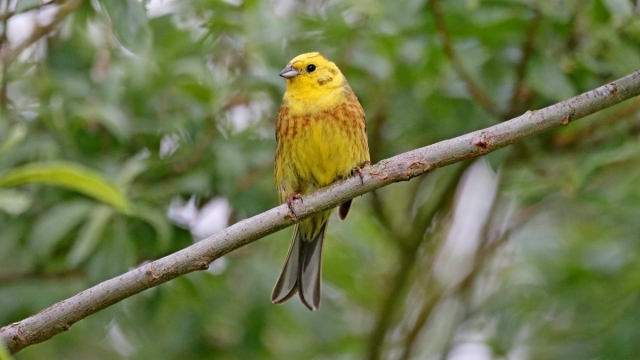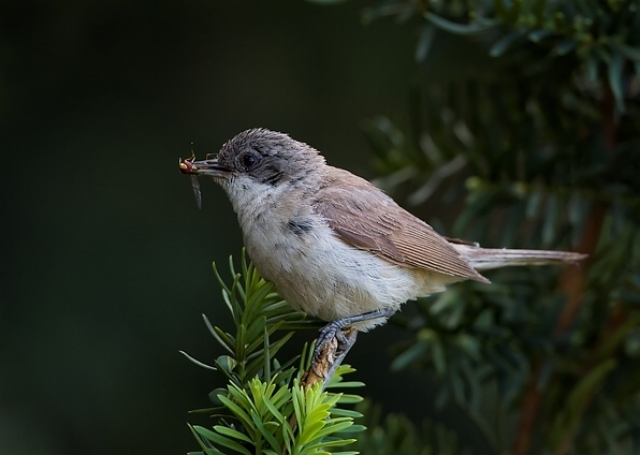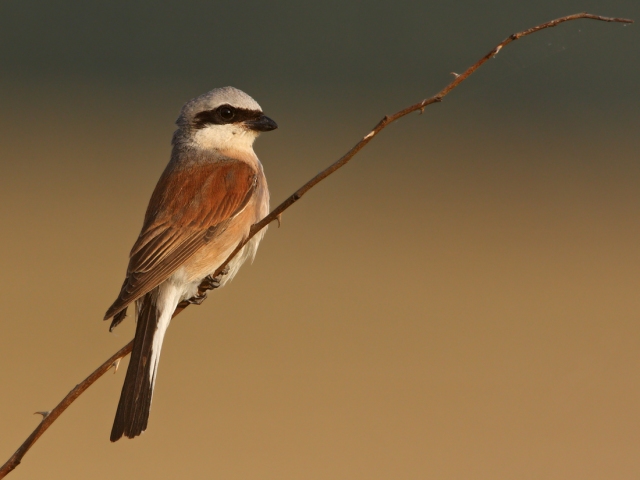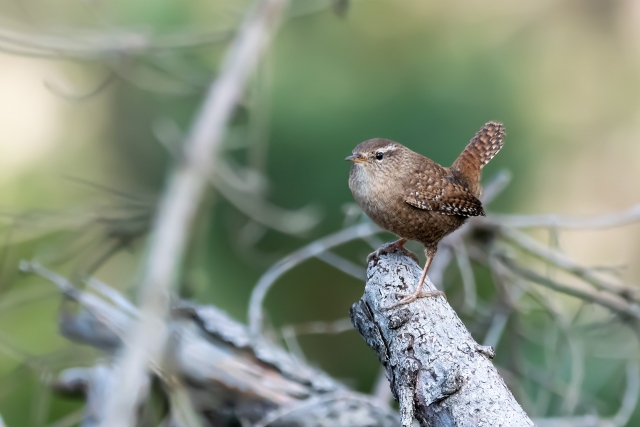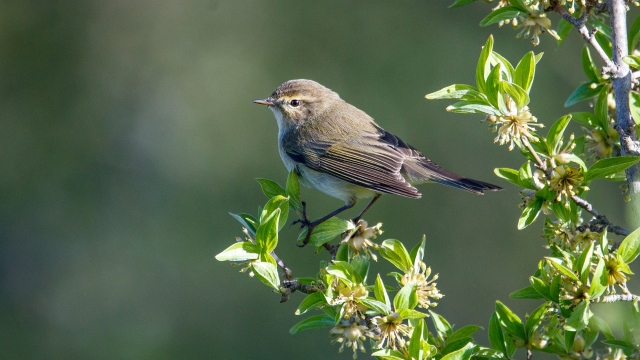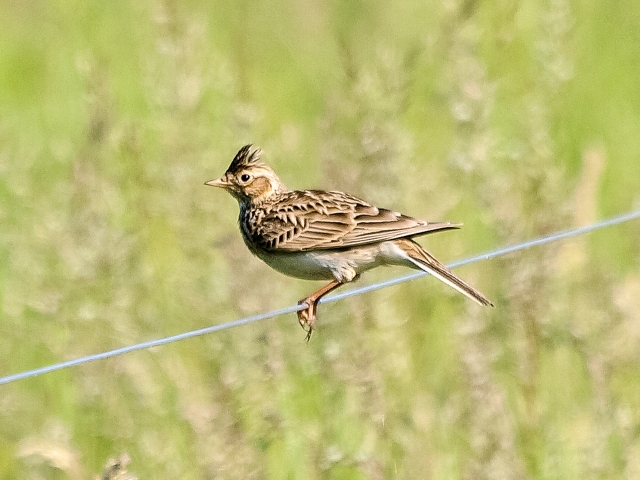Florian Heigl
Marsh warbler
Description
The marsh warbler is about 13 cm long and has a wingspan of 17 to 21 cm. The weight is about 11 to 14 grams. The upperparts are greyish brown, the underparts are yellowish white. The small bird has a whitish throat and a pointed beak. Males and females have the same colouring. The marsh warbler moves skilfully in dense vegetation and imitates the calls and songs of other bird species, which it mixes with typical reed warbler phrases. It can often be heard in late twilight and at night.
Habitat
The marsh warbler lives in dense reeds, bushes and crop fields near water bodies.
The text is a translation of an excerpt from Wikipedia (https://de.wikipedia.org/wiki/Sumpfrohrsänger). On wikipedia the text is available under a „Creative Commons Attribution/Share Alike“ licence. Status: 22 November 2021
Eurasian tree pipit
Description
With an average body length of 15 cm, the Eurasian tree pipit is about the same size as a house sparrow. However, it is more delicate and slender than the latter and thus appears visually larger. The wing length of male birds averages just under 90 mm, while the wings of females are about four to five mm shorter.
The body weight of the Eurasian tree pipit during the breeding period is about 22 to 24 grams. At the beginning of the autumn migration, the birds are regularly heavier; particularly well-fed birds can then weigh over 30 grams. Eurasian tree pipits on their return flight from their wintering grounds in Africa have occasionally been found to weigh as little as 16 grams.
The plumage does not differ between the sexes. The upperparts are yellowish to olive brown with diffuse blackish longitudinal stripes, which are more pronounced on the upper part of the head. The rump and uppertail coverts are slightly greener than the rest of the upperparts and are only faintly streaked in some individuals. The underparts are cream to yellowish with a strong streak on the breast and crop sides. The throat, breast and sides of the neck are more yellow. The stripes on the flanks are clearly less broad than on the breast. The outer feathers are partially white. The wing coverts are lightly fringed, forming two light, cream-coloured wing bands. The fringes formed by the tip fringes of the middle arm coverts are the most distinct. The tail overhangs the wing tips by about 3.5 cm.
Above the eye is a pale supercilium, not always clearly visible. The iris is dark brown, the eye ring formed by two rows of feathers is cream-coloured. The nostrils are exposed. The upper side of the beak and the tip of the lower bill are blackish brown. The rest of the lower beak becomes lighter towards the root and the lower chin and is yellowish to flesh coloured. The legs are reddish flesh-coloured, while the feet are pinkish to yellowish flesh-coloured. The talons are pale horn-coloured.
Species-specific to the Eurasian tree pipit is a strongly curved hind talon, which can be between 6.6 and 8.6 mm long. Compared to the hind toe, it is either shorter or at most the same length. In larks as well as in the other members of the peepers, the hind toe is longer and less curved.
possible confusion with other bird species
The meadow pipit is so similar to the Eurasian tree pipit that its flight and way of life, as well as its song, must be used for identification - in addition to a few minor distinguishing features in body structure and plumage colouration. The characteristic features of the Eurasian tree pipit, described above, can only be used for identification in the field under very good observation conditions. In contrast to the more delicate meadow pipit, the Eurasian tree pipit has a stronger beak and a more yellowish breast.
The woodlark, which can also be observed in the habitat of the Eurasian tree pipit and has a similar plumage colouration to the Eurasian tree pipit, can be distinguished from it by its much shorter tail and its more prominent and lighter cream-coloured supercilium.
Habitat
As a ground-breeding bird, the Eurasian tree pipit needs a habitat during its breeding period which, in addition to a stand of tall trees or shrubs, has enough open spaces with a sufficiently dense herb layer. Accordingly, Eurasian tree pipits are absent from extensive arable landscapes or grassland areas. The bird is not tied to a particular tree species. It occurs in coniferous forests as well as in deciduous or mixed deciduous forests.
In addition to scattered, sunny forest edges, clear-cuts, afforestation areas and forest clearings as the most important breeding habitats, Eurasian tree pipits also use heaths, vineyards and moors, provided they have sufficient tree cover and a dense herb layer. Sun-exposed sites are preferred. They are rarely seen in cemeteries, orchards or parks because the herb layer is usually not dense enough.
The altitudinal distribution of the Eurasian tree pipit is also influenced by the presence of herbaceous or dwarf shrub layers. It regularly occurs up to the tree line. In the Alps, it breeds up to an altitude of 2300 m, and in Austria the bird's main distribution is even in the montane zone of the Alps.
The text is a translation of an excerpt from Wikipedia (https://de.wikipedia.org/wiki/Baumpieper). On wikipedia the text is available under a „Creative Commons Attribution/Share Alike“ licence. Status: 22 November 2021
Willow warbler
Description
The willow warbler is about eleven to thirteen cm long and has a wingspan of 17 to 22 cm. The weight is about eight to eleven grams. It is difficult to distinguish in appearance from the common chiffchaff (Phylloscopus collybita). Its upperparts are green to olive-brown, its underparts yellowish-white. The small bird has a yellowish throat, breast and over-eye streak. Males and females have the same colouration.
A willow warbler can live up to twelve years.
difference to the common chiffchaff
In Central Europe, the willow warbler is easily confused with the very similar and also common common chiffchaff; they are sibling species. The willow warbler is somewhat more slender and long-winged than the common chiffchaff. The legs of the willow warbler are usually much lighter, the supercilium is longer and more pronounced, especially behind the eye. The primaries projection, i.e. the projection of the primaries over the tertials, is much larger in the willow warbler. Furthermore, in the common chiffchaff the fifth primary has a narrowing on the inside of the outer vane, which is absent in the willow warbler. However, this distinctive feature can only be recognised if the birds are held in the hand.
Habitat
The long-distance migrant is present in almost all of Central and Northern Europe from April to September. The willow warbler lives in sparse deciduous and mixed forests, parks, wetlands, shrublands and gardens.
The text is a translation of an excerpt from Wikipedia (https://de.wikipedia.org/wiki/Fitis). On wikipedia the text is available under a „Creative Commons Attribution/Share Alike“ licence. Status: 22 November 2021
Yellow bunting
Description
The yellow bunting reaches a body length of 16 to 17 cm and weighs 25 to 30 grams. During the breeding season, the males wear a yellow nuptial dress with a bright yellow head with a few brownish stripes, a yellow underpart with a reddish breast and brownish-grey wing coverts. The upperparts are brown with darker longitudinal stripes, the rump is cinnamon brown. The tail is dark, in flight the white outer edge is noticeable. Females are more inconspicuous greenish brown, but still with yellow tendencies on the throat and underparts. In plain dress, the males resemble the females.
The yellow bunting can be distinguished from the similar-looking cirl bunting by its cinnamon-brown rump.
Habitat
Yellow buntings live in open cultivated landscape with copses, hedges and bushes. In winter, they move around in large mixed troops and search for remaining seeds in fields.
The text is a translation of an excerpt from Wikipedia (https://de.wikipedia.org/wiki/Goldammer). On wikipedia the text is available under a „Creative Commons Attribution/Share Alike“ licence. Status: 22 November 2021
Lesser whitethroat
Description
The lesser whitethroat is 11.5 to 13.5 cm in length and weighs 12 to 16 grams. The upperparts are grey-brown, the crown and the relatively short tail are greyer, the underparts are white. The flanks are slightly tinged with light brown. The throat is whitish, the head is grey and the legs dark. The iris is dark, the lower eyelid is light. The grey, demarcated ear covers are the most reliable identification mark. Males and females have the same colouration. A lesser whitethroat can live up to eleven years.
Habitat
The lesser whitethroat lives in gardens, parks, mountains and open woodland areas.
The text is a translation of an excerpt from Wikipedia (https://de.wikipedia.org/wiki/Klappergrasmücke). On wikipedia the text is available under a „Creative Commons Attribution/Share Alike“ licence. Status: 22 November 2021
Eurasian blackcap
Description
The Eurasian blackcap is 13.5 to 15 cm long and has a wingspan of 20 to 23 cm. It weighs between 15 and 22 grams.
The upperparts are dark grey, the underparts olive grey. The throat and undertail coverts are pale, the iris always black. The tail is always dark, lighter at the base and without white. The flanks are slightly brownish, more so in females and young than in males. The beak and legs are grey.
The black feather cap is characteristic of the males. The scientific species name "atricapilla" (Latin for "blackhead") and the common name Schwarzplattl, which is widespread in Austria and Bavaria, refer to this. Females and young birds have a reddish-brown cap. Males in their first winter have a brown, black or a mixture of both colours.
Habitat
In Central Europe, the Eurasian blackcap is distributed almost everywhere, with the exception of treeless and shrubless areas and the high mountains from about 1500 metres above sea level, with the highest densities in riparian forests, damp mixed forests and shady parks. Treeless shrub stands are avoided. Outside the breeding season it usually stays in bushes that bear many berries, then also in open countryside. In the wintering area it is very versatile in its choice of habitat. The blackcap also breeds in the middle of large cities in bushy and tree-covered gardens and parks. In its choice of breeding territory, the blackcap is the most versatile warbler in Central Europe. It prefers semi-shady places to dry, open and sunny areas. It prefers deciduous woodland to coniferous woodland, but may locally occur more in evergreen vegetation, such as ivy or laurel woodland.
The text is a translation of an excerpt from Wikipedia (https://de.wikipedia.org/wiki/Mönchsgrasmücke). On wikipedia the text is available under a „Creative Commons Attribution/Share Alike“ licence. Status: 01 December 2021
Red-backed shrike
Description
With a length of 16-18 cm, the red-backed shrike is the smallest Central European shrike species. Males and females differ clearly in colouration.
The wing length averages 93 (91-95) mm, in the male it is between 88 and 100 mm, in the female between 82 and 98 mm. The length of the tail is between 71 and 90 mm in the male, and between 68 and 85 mm in the female. The average weight of the male is about 28 grams. In females it can increase to 32.8 grams during the breeding season and is about 28.5 grams outside the breeding season. Before migration, fat deposits can be formed and the weight increased to a maximum of 37 grams. However, this does not seem to be the rule.
Male
The male has a rusty brown to chestnut brown back and shoulder plumage, as indicated by the name " red-backed shrike". The top of the head and the nape of the neck stand out clearly with their light blue-grey. Like other Lanius species, red-backed shrikes have a narrow, black facial mask in which the dark eye, seen from a distance, often disappears almost completely. The mask is sometimes bordered from the grey top of the head by an indistinct, blurred white supercilium, which is often slightly more pronounced behind the eye. The wing coverts are reddish brown with distinctly lighter and redder margins; the primaries are chestnut brown with lighter margins and the seccondaries unmargined dark brown. In rare cases there is a white patch. This is formed by a more or less pronounced white pattern at the base of the primaries The rump is - partly up to the lower back - grey. The tail shows a contrasting black and white, spoon-shaped pattern: the middle tail feathers are mostly black, followed by feathers with a lot of white in the upper area, which increases towards the outer tail feathers. The control feathers are narrowly white fringed at the tips. The underparts are mostly whitish to cream, often the flanks and breast are slightly tinged with salmon to pink.
Female
In contrast to the male, the female does not have a grey upper head. The female's entire upperparts are a solid reddish brown, usually slightly less vivid than the male. The facial mask is more indistinct, usually dark brown to blackish, the eye stands out more clearly from it. The light supercilium is more prominent. The tail is mostly brown with white edges. The underparts are cream to beige in colour and show dark scales on the chest and flanks, some only hinting at them and some with strong scales ("sparrowhawk"). This is sometimes also very pale on the back. With age, the scales may fade, and the female's colouring becomes more and more similar to that of the male.
Lebensraum
The red-backed shrike inhabits well-managed, sunny terrain with open areas of low or sparse vegetation (e.g. shrubberies, meadows, dry grasslands) alternating with scattered hedgerows or copses with less than 50 percent cover. It needs one to three metre high shrubs as roosts for hunting and territorial observation and as nest sites. Briars such as sloes, hawthorns or hedge roses are preferred, but they do not have to be present in large numbers under otherwise favourable conditions.
Accordingly, the red-backed shrike likes to colonise grassland and pastureland rich in hedges, wet fallows, partially drained moors with dam cultures, orchards as well as clearings, windthrow and clear-cut areas or young plantations within forests. In natural regions, forest edges or clearings, especially moist sites, e.g. fringes of alder swamps or willow forests, are of particular importance.
These habitat requirements are predestined for the red-backed shrike in extensively used cultural landscapes - i.e. small-scale habitats divided by hedges and copses and characterised by extensive pasture farming.
Today, the red-backed shrike can often only be found in suitable marginal areas of the cultivated landscape, for example on fallow, scrubby areas, on clear-cut areas and young plantations, even within closed forests, at landfills, gravel pits or motorway embankments and railway embankments.
The text is a translation of an excerpt from Wikipedia (https://de.wikipedia.org/wiki/Neuntöter). On wikipedia the text is available under a „Creative Commons Attribution/Share Alike“ licence. Status: 01 December 2021
Eurasian wren
Description
The Eurasian wren is round in shape and usually has a raised tail. The pointed, slightly curved beak is blackish brown in the upperpart and yellowish in the underpart. The iris of the eye is nut brown. The plumage is reddish brown on top and pale brown on the underpart. An indistinct cream-coloured over-eye line ends at the dark ear coverts. There are dark brown wavy lines on the tail, wings and flanks. Males and females look the same. While the wings of the female are 45 to 48 mm long, those of the male are between 49 and 53 mm long. The feet are flesh-coloured to brownish. Wrens have a body length of 9.5 to 11 cm. The wingspan is 14 to 15 cm and the body weight is usually between 7.5 and 11 grams.
The wren can climb vertically up a trunk with its long toes and strong talons, but cannot descend headfirst. It flies straight and level over the ground with rapid wing beats.
Habitat
The wren lives in bushes, hedges and in the thickets of woods, gardens and parks. If there are enough hiding places, it can be found in the open cultivated landscape. Its preferred habitats include floodplains with exposed roots and climbing plants as well as woods and copses rich in undergrowth. It often inhabits areas near bodies of water. The Eurasian wren hibernates in woods, parks and gardens with covering shrubs and a herb layer, often near large bodies of water. It is often found solitary in barns and stables, in semi-natural gardens also on the walls of houses, usually gardens with a pond. It is not particularly shy there.
The text is a translation of an excerpt from Wikipedia (https://de.wikipedia.org/wiki/Zaunkönig). On wikipedia the text is available under a „Creative Commons Attribution/Share Alike“ licence. Status: 01 December 2021
Common chiffchaff
Description
Common chiffchaffs are small, compact and short-winged leaf warblers with a rather large head and without conspicuous markings. The body length is 10-12 cm, the weight 6-10 g. The sexes do not differ in appearance and weight, but males are slightly longer-winged than females.
The upperparts are greyish-brownish green, the rump is often slightly lighter green. The throat, the underpart of the rump and undertail coverts are dirty white with individually very variable amounts of yellow and beige on the throat and breast. Especially in autumn, the flanks are often covered in beige-brown. Wing feathers and tail feathers are grey-brown, the edges of the outer plumes are narrowly fringed with yellow-green. A yellowish supercilium is clearly visible in front of the eye, behind the eye usually only indistinctly. The dark eye stripe divides the light eye ring into a lower and an upper half. The area below the eyes and the ear coverts are quite dark, so that the lower part of the light eye ring contrasts clearly with it. The short and fine beak is usually not very noticeably bright orange at the base and sides, and dark horn-coloured for the rest. The legs are usually dark brown or greyish black, rarely lighter brown.
difference to the willow warbler
Habitat
The species inhabits a wide range of wooded habitats and is also frequently found in parks and the greened outskirts of towns. Forest areas with a structured tree layer, a well-developed shrub layer and at least a sparse shrub cover and correspondingly structured green spaces are preferred. The species hardly ever occurs in monotonous stands with largely no undergrowth, such as in closed copper beech forests. In Central Europe, the highest settlement densities are reached in alder swamp forests and wet riparian forests with 7 to 14 territories/10 ha.
The text is a translation of an excerpt from Wikipedia (https://de.wikipedia.org/wiki/Zilpzalp). On wikipedia the text is available under a „Creative Commons Attribution/Share Alike“ licence. Status: 01 December 2021
Eurasian skylark
Description
Eurasian skylarks are medium-sized, slender larks with rather long wings, a light cap that can be raised in the male, a strong beak, a relatively long tail and a long hind talon. The bird's body length is 16 to 18 cm and it weighs 30 to 45 g. The basic colour of the upperparts is beige to reddish brown. The top of the head and the back including the rump are finely streaked with blackish brown and dotted. The upper breast and flanks are clearly dark longitudinally streaked and dotted on a yellowish white or light brownish ground, the rest of the belly and the flanks are white.
The wingspan ranges from 30 to 35 cm. The wings are dark grey-brown, the inner primaries and secondaries have a narrow whitish terminal band. The tail is grey-brown, on the fifth tail feather counted from the inside outwards the outer vane is narrowly whitish fringed, on the outermost (sixth) tail feather the outer vane is almost completely whitish and also the inner vane on the distal half is predominantly whitish.
The yellowish white, strong over-eye stripe ends at the rear edge of the ear coverts. These are strong reddish brown and lightly edged. The moustachial stripe is broad white, the weakly developed chin stripe is dark grey-brown, the throat white.
The legs are light brown. The beak is horn-coloured, the lower beak is lightened at the base. The iris is dark brown in adults and light brown in juveniles.
Habitat
The eurasian skylark inhabits not too wet, wide open spaces with low and often patchy vegetation of grasses and herbs. In Central Europe, it is largely bound to agriculturally used areas, the main breeding habitats being fertilised meadows, pastures and fields.
The text is a translation of an excerpt from Wikipedia (https://de.wikipedia.org/wiki/Feldlerche). On wikipedia the text is available under a „Creative Commons Attribution/Share Alike“ licence. Status: 14 December 2021




